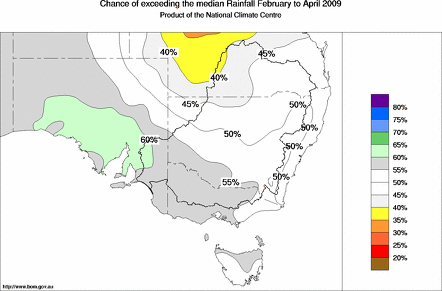| Southeastern Aust Seasonal Rainfall Outlook: probabilities for February to April 2009, issued 22nd January 2009 | |||||||||
Wetter than average conditions indicated for parts of South AustraliaThe outlook for total February to April rainfall indicates a moderate shift towards wetter than average conditions over the pastoral districts of South Australia. However, over the remainder of southeastern Australia the outlook shows no strong bias towards either wetter or drier conditions. 
Over the pastoral districts of South Australia, the chances of February to April totals exceeding the 3-month median rainfall are around 60% (see map). This means for every ten years with ocean patterns like the current, about six years are expected to be wetter than average while about four years are drier. Over the remainder of southeastern Australia the chance of exceeding the February to April median is between 45% and 60%. This means the chances of being wetter than normal in these areas are about the same as the chances of being drier. Outlook confidence is related to how consistently the Pacific and Indian Oceans affect Australian rainfall. History shows this effect at this time of year to be moderately consistent over the SE and NW of NSW and the far west of SA, and at best only weakly consistent over the remainder of NSW and SA (including the pastoral districts), most of Victoria and all of Tasmania (see background information). In these areas where outlook confidence is not high caution should be used when interpreting these outlooks. Indian Ocean temperatures in the vicinity of Australia, which were significantly above average in October, cooled in the last months of 2008, though in recent weeks there has been some warming to the west and south west of southern Western Australia. The Indian Ocean Dipole is neutral and expected to remain neutral through the remainder of summer. (For more information on how Indian Ocean temperatures impact on Australian rainfall click here. The central and eastern equatorial Pacific Ocean cooled further during December. This brings the Pacific Ocean into line with atmospheric indicators, a number of which have been approaching La Niña levels since October 2008. However, most current model outlooks, and a build-up of warmer sub-surface water in the western equatorial Pacific, suggest that the cooler conditions in the Pacific may not persist beyond summer 2009. The most likely scenario is for the central and eastern Pacific to warm over the coming months and hence remain neutral. The SOI remains positive at approximately +13 for the 30 days ending 19 January. For routine updates and comprehensive discussion on any developments please see the ENSO Wrap-Up. | |||||||||
Click on the map above for a larger version of the map. Use the reload/refresh button to ensure the latest forecast map is displayed. More detailed forecast maps, including the probabilities of seasonal rainfall exceeding given totals, can be found here. | |||||||||
|
More information on this outlook is available Monday to Friday from 9.00am to 5.00pm local time by contacting the Bureau's Climate Services sections in Queensland, NSW, SA, Victoria and Tasmania at the following numbers:
| |||||||||
THE NEXT ISSUE OF THE SEASONAL OUTLOOK IS EXPECTED BY 20th February 2009 Corresponding temperature outlook | |||||||||
Background Information
| |||||||||









